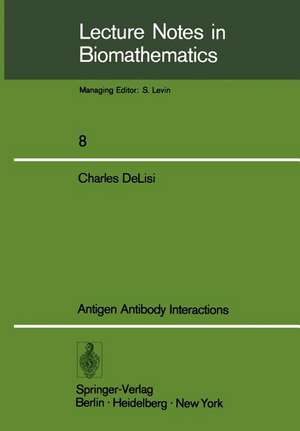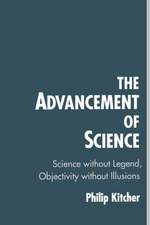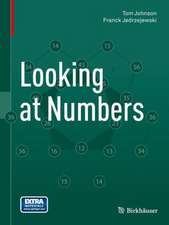Antigen Antibody Interactions: Lecture Notes in Biomathematics, cartea 8
Autor C. Delisien Limba Engleză Paperback – iun 1976
Din seria Lecture Notes in Biomathematics
-
 Preț: 378.54 lei
Preț: 378.54 lei -
 Preț: 380.45 lei
Preț: 380.45 lei -
 Preț: 413.37 lei
Preț: 413.37 lei -
 Preț: 390.63 lei
Preț: 390.63 lei -
 Preț: 396.24 lei
Preț: 396.24 lei -
 Preț: 387.38 lei
Preț: 387.38 lei -
 Preț: 385.08 lei
Preț: 385.08 lei - 5%
 Preț: 366.56 lei
Preț: 366.56 lei -
 Preț: 384.70 lei
Preț: 384.70 lei -
 Preț: 388.13 lei
Preț: 388.13 lei -
 Preț: 394.29 lei
Preț: 394.29 lei - 5%
 Preț: 389.93 lei
Preț: 389.93 lei - 5%
 Preț: 370.74 lei
Preț: 370.74 lei -
 Preț: 384.86 lei
Preț: 384.86 lei -
 Preț: 387.96 lei
Preț: 387.96 lei -
 Preț: 404.29 lei
Preț: 404.29 lei -
 Preț: 391.61 lei
Preț: 391.61 lei -
 Preț: 384.48 lei
Preț: 384.48 lei -
 Preț: 384.48 lei
Preț: 384.48 lei -
 Preț: 383.71 lei
Preț: 383.71 lei -
 Preț: 379.68 lei
Preț: 379.68 lei -
 Preț: 384.09 lei
Preț: 384.09 lei -
 Preț: 405.66 lei
Preț: 405.66 lei -
 Preț: 379.48 lei
Preț: 379.48 lei -
 Preț: 400.65 lei
Preț: 400.65 lei -
 Preț: 385.25 lei
Preț: 385.25 lei -
 Preț: 390.25 lei
Preț: 390.25 lei -
 Preț: 395.47 lei
Preț: 395.47 lei -
 Preț: 378.71 lei
Preț: 378.71 lei -
 Preț: 382.95 lei
Preț: 382.95 lei - 15%
 Preț: 578.01 lei
Preț: 578.01 lei -
 Preț: 380.84 lei
Preț: 380.84 lei -
 Preț: 405.66 lei
Preț: 405.66 lei -
 Preț: 399.12 lei
Preț: 399.12 lei -
 Preț: 410.66 lei
Preț: 410.66 lei -
 Preț: 385.62 lei
Preț: 385.62 lei - 5%
 Preț: 371.10 lei
Preț: 371.10 lei -
 Preț: 378.71 lei
Preț: 378.71 lei -
 Preț: 386.99 lei
Preț: 386.99 lei -
 Preț: 401.61 lei
Preț: 401.61 lei -
 Preț: 350.30 lei
Preț: 350.30 lei -
 Preț: 383.33 lei
Preț: 383.33 lei -
 Preț: 408.54 lei
Preț: 408.54 lei -
 Preț: 398.53 lei
Preț: 398.53 lei -
 Preț: 399.67 lei
Preț: 399.67 lei -
 Preț: 391.79 lei
Preț: 391.79 lei -
 Preț: 384.86 lei
Preț: 384.86 lei -
 Preț: 401.61 lei
Preț: 401.61 lei -
 Preț: 392.60 lei
Preț: 392.60 lei -
 Preț: 406.05 lei
Preț: 406.05 lei
Preț: 381.21 lei
Nou
Puncte Express: 572
Preț estimativ în valută:
72.94€ • 76.36$ • 60.36£
72.94€ • 76.36$ • 60.36£
Carte tipărită la comandă
Livrare economică 05-19 aprilie
Preluare comenzi: 021 569.72.76
Specificații
ISBN-13: 9783540076971
ISBN-10: 3540076972
Pagini: 152
Ilustrații: IV, 142 p.
Dimensiuni: 170 x 244 x 8 mm
Greutate: 0.25 kg
Ediția:Softcover reprint of the original 1st ed. 1976
Editura: Springer Berlin, Heidelberg
Colecția Springer
Seria Lecture Notes in Biomathematics
Locul publicării:Berlin, Heidelberg, Germany
ISBN-10: 3540076972
Pagini: 152
Ilustrații: IV, 142 p.
Dimensiuni: 170 x 244 x 8 mm
Greutate: 0.25 kg
Ediția:Softcover reprint of the original 1st ed. 1976
Editura: Springer Berlin, Heidelberg
Colecția Springer
Seria Lecture Notes in Biomathematics
Locul publicării:Berlin, Heidelberg, Germany
Public țintă
ResearchCuprins
1. Introduction.- 1. Organization of the Immune System.- 2. Antibody Structure.- 3. The Theory of Clonal Selection.- 2. Hinge and Valence Effects on Antibody Binding Properties.- 1. General Considerations.- 2. The Two-Particle Probability Density Function.- 3. The Crothers-Metzger Model.- 4. Analysis of Experiments.- 5. Immunological Implications.- 3. Combining site heterogeneity. The free energy distribution function.- 1. Statement of the Problem.- 2. Inversion of the Binding Curve.- 3. Intramolecular Reactions.- 4. Immunological Implications.- 4. Combining Site Heterogeneity. Immunodiffusion.- 1. General Remarks.- 2. A Simple Diffusion-Reaction Model for Plaque Formation.- 3. The Solution.- 4. Applications.- 5. The Theory of Plaque Growth Kinetics For A Lymphocyte SOURCE.- 1. Introduction.- 2. A Diffusion-Reaction Model.- 3. Solutions Under Limiting Conditions.- 4. Models Allowing Reversible Reactions.- 5. A Diffusion-Transport-Reaction Model. Electrophoresis.- 6. Predictions of the Theory.- 6. Plaque Inhibition: Growth In The Presence Of Competitive Interactions.- 1. Introduction.- 2. IgG Plaque Inhibition.- 3. Predictions.- 7. Applications Of Plaque Growth Theory And Immunological Implications.- 1. The IgM Response.- 2. The IgG Response.- 3. Summary of Conclusions.- 8. Dynamical Phenomena on Lymphocyte Membranes.- 1. Background and Definitions.- 2. The Dynamics of Antigen-Antibody Aggregation in Three Dimensions.- 3. Critical Coalescence on Lymphocyte Membranes.- 4. Immunological Implications of the Model.- 5. Future Problems.














